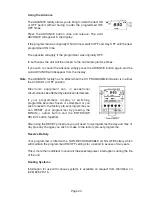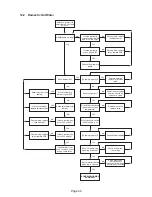
6.3.1 Installation of a Balanced Flue (BF-R, HLBF-R & VBF)
1.
Make a suitable sized hole in the wall or ceiling for the flue kit. Add the dimensions
given on pages 6 (Dimension G) and 8 (Flue Vertical Dimension). The cavities around
the opening must be sealed and protected by a non-combustable sleeve.
2.
Remove the top panel (kitchen and utility models) and the combustion chamber lid.
3.
Remove the flue ring from the top of the boiler (3 screws) ensuring that any remaining
silicone sealant has been cleaned away.
4.
Carefully fit the inner and out seals to the flue adaptor.
Note
: After fitting the seals to the flue smear them with soap or any suitable lubricant
which does not react with the silicone rubber.
5.
Place the gasket correctly on the boiler and locate the flue adaptor over this, fixing it in
position using the nuts and bolts provided. For BF-R side outlet options on white case
boilers it will be necessary to manoeuvre the adaptor through the side panel before
fixing it to the boiler after the blanking plate has been removed. Push boiler into position
against the wall.
6.
If fitting extension pieces ensure the seals are correctly fitted and lubricated before
pushing through the wall and attaching to the flue adaptor.
Note
: Any combination of short (300mm) and long (600mm) extension pieces for the
BF-R can be used up to a maximum additional length of 1200mm.
7.
Slide the flue terminal into position with a twisting movement ensuring that it protrudes
through the wall by a minimum of 175mm and a maximum of 225mm or through the
roof by a minimum of 665mm.
8.
Seal the gap between the flue and the wall both inside and out after which the protective
basket must be fitted to the wall over the flue terminal.
9.
After removing the air inlet cover fit the air intake adaptor spigot and gasket to the
burner. Connect one end of the air duct to the flue and the other end to the air intake
spigot on the burner. Both ends should be securely fastened with the jubilee clips.
10.
The boiler is now ready to be connected to the plumbing, oil supply and mains electricity.
11.
The baseplate of the Goldbird and Whitebird has been designed to allow the oil pipe
and electric cable to pass unnoticed inside the unit from the rear of the installation.
Alternatively the grommeted holes either side, towards the front of the baseplate, can
be used.
12.
A test hole for commissioning purposes has been provided on the boiler lid.
Page 30
















































